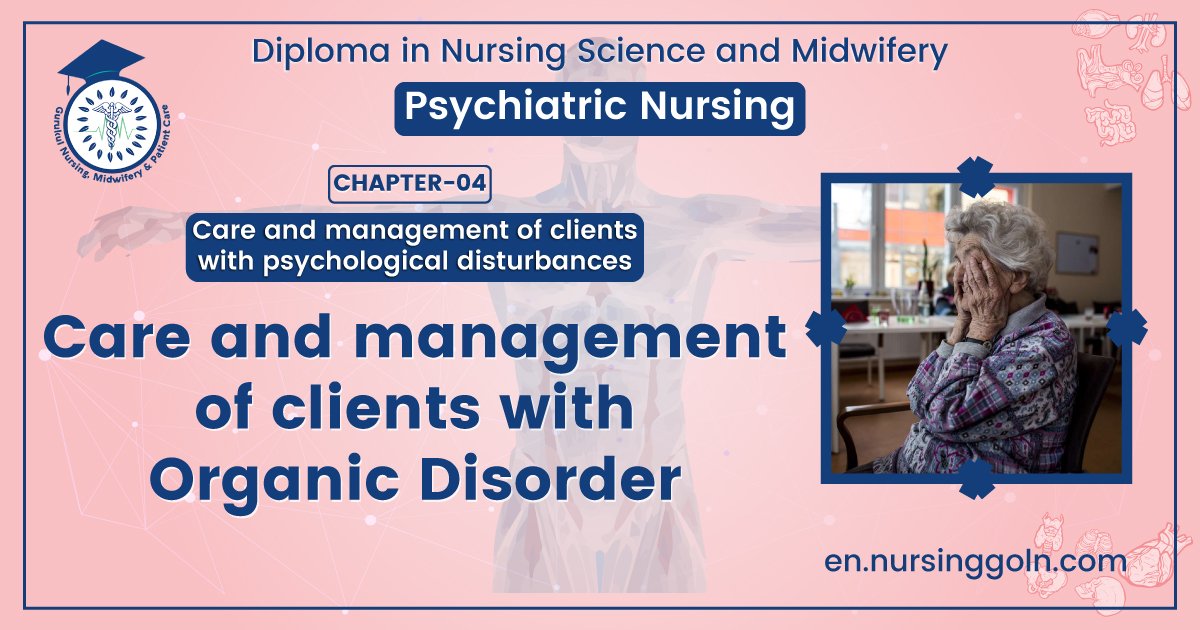Care and management of clients with Organic disorder– This book covers the entire syllabus of “Psychiatric Nursing” prescribed by the Universities of Bangladesh- for Basic and diploma nursing students. We tried to accommodate the latest information and topics. This book is an examination-friendly setup according to the teachers’ lectures and examination questions.
At the end of the book previous university questions are given. We hope in touch with the book students’ knowledge will be upgraded and flourish. The unique way of presentation may make your reading of the book a pleasurable experience.

Care and management of clients with Organic disorder
Organic mental disorders are psychiatric disturbance resulting from transient or permanent central nervous system dysfunction. These are mental illnesses caused by an underlying brain pathology.
[Ref: S Nambi/2/112]
Or
“The syndrome attributed to cerebral or brain disease or disorder’.
[Ref: KP Neeraja/1/Vol-2/542]
Or
It may be defined as an acute or chronic, behavioural or psychological disorders associated with transient or permanent brain dysfunction.
[Ref: KP Neeraja/1″/Vol-2/542]
Or
‘A pattern of organic psychological and behavior symptoms associated with permanent or transient brain dysfunction but without reference to etiology”
Classification of organic brain disorder:
All these disorders are associated with transient or permanent dysfunction of the brain. Organic mental disorders are classified as:
1. Acute organic mental disorder (Delirium)
2. Chronic organic mental disorder (Dementia).
[Ref: S Nambi/2/112/]
Causes of organic brain disorder:
1. Cerebral diseases
2. Brain injury/head injury or trauma
3. Insult leading to cerebral dysfunction
4. CNS systemic diseases or disorders
5. Metabolic disorder complications
6. Toxic conditions
7. Encephalitis, systemic infection
8. Brain tumour or cerebral arteriosclerosis
9. Fever.
Manifestations of organic brain disorder:
1. Impairment in cognitive functions, e.g. thinking, memory, reasoning, orientation, judgment, intelligence, emotional adjustment
2. Impaired processing of incoming information
3. Depression
4. Mild motor disability tremors
5. Loss of dexterity
6. Imbalance.
[Ref: KP Neeraja/1/Vol-2/542)
Dementia
It is defined as, a global impairment of cognitive function, and is typically progressive and non- reversible.
Or
[Ref-Davidson’s/24 edition/
Dementia is a syndrome due to disease of the brain, chronic and progressive in nature. There is disturbance of multiple higher cortical functions, including memory, thinking, and orientation, comprehension, learning capacity, language and judgment.
Or
[Ref: S Nambi/2/115/]
‘A chronic progressive disease of the brain affecting higher cortical functions in multiple ways and resulting into disturbances or decline in intellectual functioning. For example, memory, thinking. orientation, comprehension, learning capacity, calculation, language and judgement but not affecting consciousness commonly associated with deterioration in emotional control and social behaviour.
(Ref: ICD-10, WHOJ)
Classification of dementia:
1. Senile dementia of Alzheimer’s type
2. Vascular dementia
3. Dementia in other diseases
➤In Pick’s disease
➤In Creutzfeldt-Jakob disease
➤In Huntington’s disease
➤In Parkinson’s disease
➤ In HIV disease
4. Unspecified dementia.
[Ref: S Nambi/24/115]
Causes of dementia:
1. Primary neurodegenerative disorders:
- Alzheimer’s disease.
- Dementia with Lewy bodies.
- Pick’s disease.
- Other frontotemporal dementia.
- Parkinson’s disease.
- Huntington’s disease.
2. Vascular:
- Vascular dementia,
- Multiple strokes.
- Focal thalamic,
- Basal ganglia strokes.
- Subdural haernatoma.
3. Inflammatory and autoimmune:
- SLE and other vasculitides with CNS involvement.
- Behcet’s disease.
- Neurosarcoidosis.
- Hashimoto’s encephalopathy.
- Multiple sclerosis.
4. Traumatic:
- Severe head injury.
- Repeated head trauma in boxers (dementia pugilistica). Other.
5. Infections and related conditions:
- HIV.
- latrogenic and variant CJD (prion disease).
- Neurosyphilis.
- Post-encephalitic.
- Lyme disease
6. Metabolic and endocrine:
- Sustained uraemia.
- Renal dialysis.
- Liver failure.
- Hyperthyroidism.
- Hypoglycaemia.
- Cushing syndrome.
- Hypopituitarism.
- Adrenal insufficiency.
7. Neoplastic:
- Intracranial space occupying lesions carcinomatous meningitis
- Limbic encephalitis
8. Post-radiation:
- Acute and subacute radionecrosis.
- Radiation thrombocoagulopathy.
- Radiation leucodystrophy.
9. Pest-anoxic:
- Severe anaernia.
- Post surgical (especially cardiac bypass).
- Carbon monoxide poisoning.
- Cardiac arrest.
- Chronic respiratory failure.
10 . Vitamin and other nutritional deficiency:
- Sustained lack of vitamin B12.
- Folate
- Alcohol poisoning with heavy metals.
11. Toxic:
- Organic solvents.
- Organophosphates
12. Other:
- Normal pressure hydrocephalus
(Ref: S Nambi/2/115-116/)
Causes of dementia can be categorized as following:
| Common Causes | Less Common Causes | Potentially Treatable Causes |
|
|
|
Classification of dementia:
1. Senile dementia of Alzheimer’s type.
2. Vascular dementia.
3. Dernentia in other diseases.
✔In Pick’s disease.
✔In Creutzfeldt-Jakob disease.
✔In Huntington’s disease.
✔In Parkinson’s disease.
✔In HIV disease.
✔Unspecified dementia.
Clinical features of dementia:
1. Affected persons may be disoriented in time, in place and in person
2. Forgetfulness with effects at work; they may forget names or appointments as memory function is declined
3. Difficulties with familiar activities, e.g. absent mindedness like keeping vessel on the stove and forgetting.
4. Language difficulties, e.g. difficulty in finding right words, inappropriate filling-up of words, which others cannot be able to understand it (aphasia)
5. Problem with spatial and temporal orientation, e.g. forgets the day of the week or they may lost in unfamiliar surroundings
6. Impaired capacity of judgement, ie, people with dementia cannot be able to judge the things by themselves like wearing inappropriate clothes based on seasonwise
7. Problems related to abstract thinking, e.g. the clients cannot be able to do simple calculations
8. Leaving things behind, e.g. clients will forget where they left their belongings like purse, umbrella.
9. Clients may have sudden mood swing, depressed
10. Pronounced personality changes suddenly or over a longer period of time, e.g. a person who is friendly in nature, with dementia suddenly becomes aggressive without any reason, mentally fatigue
11. Loses interest in their work and hobbies, manifests lack of interest or zeal in cultivation of new activities.
12. Possesses stereotyped behaviour
13. Neurological syndrome: drowsiness, confusion, ataxia
14. Catastrophic reactions, e.g. agitation
15. Impairment in thinking and reasoning capacity, reduction in flow of ideas (Alzheimer’s type)
16. Not able to attend more than one stimuli at a time.
17. Unable to follow social norm
18. Isolation, withdrawal
19. Inappropriate, indecent behaviour, e.g. lack of interest in hygiene
20. Lack of emotional control
21. Development of functional reactions, e.g. anxiety, depression, paranoid delusions
[Ref: KP Neeraja/1/Vol-2/545)

Impairments in dementia:
1. Memory
2. Thinking and judgment
3. Orientation
4. Comprehension and learning capacity
5. Calculation
6. Language.
[Ref: S Nambi/2/116-117]
Diagnostic criteria of dementia:
1. Evidence of organic change
2. Evidence of impairment in short- and long-term memory.
3. Impairment in abstract thinking, judgment and higher cortical function and personality change
4. Disturbance that are interfering with work and social activities
Investigation of dementia:
A. In most patiens:
- Imaging of head (CT and/or MRI)
- Blood tests:
- Full blood count, ESR
- Urea & electrolytes, glucose
- S. calcium
- Liver function test.
- Thyroid function tests
- Vitamin B12
- VDRL test
- ANA, anti-ds DNA
- Chest X-ray
- EEG
B. In selected patients:
- Lumber puncture
- HIV serology
- Brain biopsy
Treatment of dementia:
1. Drup treatment: There is no specific drug which can cure dementia, but drugs like hydergine, papaverine, piracetam lecithin are claimed to improve dementia, but associated behavioral problems, psychosis, epilepsy and sleep disturbance can be treated with specific drugs
2. Psychosocial management;
a. Behavioral methods
b. Milieu therapy
c. Activity engagement
d. Physical exercise
e. Problem orientated approach
f. Reality orientation
g. Organization of psychiatric services.
3. Training of thinking and memory functions are carried out carefully
4. Reality orientation training
5. Improve brain function by using drugs, eg. psychotropic drugs, antipsychotic drugs, antidepressants, antianxiety drugs
6. Organization of environment
7. Cognitive and behavioural interventions may be appropriate
8. Educating and providing emotional support to the caregiver is of importance
9. Remotivation therapy
10. To provide opportunity for the client to derive pleasure and sensory stimulation by experiencing the world to feel safe and comfortable
11. To interrupt self-absorption
12. To overcome isolation
(Ref: S Namb/2/118+ KP Neeraja/1/Vol-2/543-546/)
Nursing management of dementia:
1. Assess patient’s level of functioning to formulate appropriate plan of care,
2. Patient’s safety is a nursing priority. Assess patient’s level of disorientation/confusion to determine specific requirements for safety.
3. Nurse the patient in familiar surroundings, without obstacles’
4. Disorientation may endanger the patient’s safety if he unknowingly wanders away from the safe environment. Always instruct the relatives to tie a plastic or aluminium identity tag so that he can be identified”
5. Dementia patients are prone to aggressive and violent behavior. The nurse should recognize these. Before the patient becomes violent and unmanageable, if necessary, use restraints, but judiciously. Maintain a calm manner with the patient, use drugs as prescribed by the doctors
6. Use simple explanations and face to face introduction and communication with the Patient
7. Decrease the amount of stimuli in the patient’s environment so that confusion will be less, eg low noise level, few people
8. Provide reassurance if patient is frightened and agitated
9. Provide feeling of security and stability by allowing the same persons to take care regularly
10. Help the patient to devise methods to reduce memory defect, eg ask them to note down the daily activities and things to be done.
11. Allow the patient to be as independent as possible in self-care activities.
12. Dementia patients may often have problems with elimination (e-g. bed wetting). Measures educate the patient’s relatives to understand the problems of incontinence and to cover the mattress may be taken.
13. Educating the carer (e.g. the relatives) about the gradual decline of mental capacities and the patient’s inability to understand the problems they have. The caregiver should understand that the patient becomes dependent and needs support for his activities of daily living.
(Ref: S Nambi/24/118-1191

Nursing care plans of dementia:
| Nursing diagnosis | Goal | Intervention | Evaluation |
| Impaired communication related language difficulties, speech problems, difficulty to in facial muscle movement | Enhances interaction adopting by good communication techniques and exercise. | Motivate the client to take deep breath before conversation Demonstrate a caring attitude and concern by showing respect and regard, and positive reinforcement when the client is trying to converse Be brief, simple and clear, approach the client in slow and gentle manner Use soft voice when conversing with the client Develop and maintain good interpersonal relationship, help the client to establish closer relationship with others Promote socially acceptable behavior. Try to avoid over correction; ignore the client for his unacceptable behavior. | Improve communication |
| Potential for injuries because of sensory deficit | Prevent injuries | Provide safe environment, e.g. closed electricity circuits, dry flooring Remove any sharp instruments from the client’s room Maintain adequate ventilation and pleasing environment. | Prevent injuries |
| Social isolation related to mood changes and depression. | Reduces social isolation by enhancing socialization | Encourage the client to interact with others Motivate the friends and family members to interact with the client frequently Be active listener, show attention and concentration, when the client is expressing or conversing his feelings Give respect, call by name, convey warmth, concern Never argue with the client Provide comfortable environment. | Social mobilization |
| Alteration in perception related to hallucinations and depression. | Adjusts to the perceptual difficulties | Make the client to be familiar with his surroundings Promote sensitivity Always one member has to be available, to help the client when the need arises Speak clearly to the client and reorient him to the things perfectly without loosing confidence Remove the objects which promote perceptual disturbances Administer the drugs as prescribed Minimize sensory provoking environment Encourage him to perform the activities of his choice Provide supervision over clients’ tasks Limit inappropriate behaviour Encourage the family members to provide support. | Decrease the incident of thought disorder |
Ref: KP Neeraja/I/Vol-21Q.
Prevention of dementia:
1. Lead an active life, both mentally and physically
2. Proper screening and treatment of underlying diseases is essential
3. Provision of situational support, mutual concern are of much importance.
4. Eating a healthy, balanced diet.
5. Maintaining a healthy weight.
6. Exercising regularly.
7. Keeping alcohol to a minimum.
8. Stopping smoking.
9. Keeping blood pressure at a healthy level.
[Ref: KP Neeraja/1/Vol-2/546 anil Lecture
Delirium:
Delirium is a transient organic mental disorder characterized by generalized physiological dysfunction, usually fluctuating in degree.
[Ref: S Nambi/2/113)
Or
Delirium is characterized by global impairment of consciousness (clouding of consciousness), resulting in reduced levels of alertness, attention, and perception of the environment.
[Ref-Michael Gelder/5/329)
It is a clinical syndrome characterized by drowsiness with disorientation, perceptual disturbances and muddled thinking.
[Ref-Kumar & Clark/8th +Davidson’s/221/250)
Or
‘It is a state of clouded consciousness in which attention cannot be sustained, the environment is wrongly perceived and disturbances of thinking are present’.
[Ref: ICD-10)
Or
‘An acute organic mental disorder characterized by impairment in attention, concentration and consciousness added by disturbances in thinking and perception’.
[Ref: KP Neeraja/1″/Vol-2/549)
Risk factors for delirium:
Divided into two groups –
A. Predisposing factors
- Old age
- Dementia
- Frailty
- Sensory impairment
- Polypharmacy
- Renal impairment
B. Precipitating factors
- Intercurrent illness
- Surgery
- Change of environment or ward
- Sensory deprivation (e.g. darkness) or overload (e.g. noise)
- Dehydration
- Medications (e.g. opioids, psychotropics)
- Pain
- Constipation
- Urinary catheterization
- Acute urinary retention
- Hypoxia
- Fever
- Alcohol withdrawal
[Ref-Davidson’s/24 edition)
Common causes of delirium:
A. Infections
- Typhoid,
- pneumonia,
- septicemia,
- puerperal sepsis,
- peritonitis
B. Intracranial infections
- Encephalitis,
- meningitis,
- neurosyphilis cerebral abscess,
- cerebral malaria.
C. Acute brain disorders
- Head injury cerebral hemorrhage,
- hypertensive encephalopathy
D. Metabolic disturbance
- Uremia,
- liver failure,
- cardiac failure,
- respiratory failure,
- electrolyte imbalance.
E. Vitamin deficiency
- Pellagra (nicotinamide deficiency),
- Wemicke’s encephalopathy (Thiamine deficiency).
F. Drug withdrawal
- Withdrawal from opiates,
- barbiturates alcohol (Delirium tremens)
G. Drug intoxication
- Atropine,
- cocaine,
- bromides.
- Alcohol introxication.
- Alcohol withdrawal
- Opiates.
Prescribed drugs. - Any sedative.
- Digoxin
- Diuretics.
- Lithium.
- Steroids.
[Ref: S Nambi/2/113-114)
Or
1. Head trauma
2. Postoperative cases
3. Heat stroke
4. High fever in children
5. Metabolic-thiamine deficiency, uremia, liver disorders, diabetic coma
6. Toxic-metallic poisoning, e.g. lead, manganese, mercury, carbon monoxide
7. Intoxication, withdrawal effects of alcoholic, sedative, hypnotic drugs
8. Infections, e.g. pneumonia, meningitis, encephalitis
9. Vascular-hypertensive encephalopathy, arteriosclerosis, intracranial haemorrhage
10. Neoplastic, e.g. space occupying lesions
11. Anoxia, e.g. anaemia, cardiac failure/congestive heart failure
12. Epilepsy and cerebral tumors
13. Lupus erythematosus, respiratory insufficiency realty
14. Sensory deprivation.
[Ref: KP Neeraja/1″/Vol-2/549)
Clinical features of delirium:
1. Sudden onset
2. Prodromal period with insomnia and nightmares
3. Clouding of consciousness, drowsiness, restlessness and inattentiveness.
4. Disorientation
5. Impaired attention span
6. Confused, incoherent and unintelligible talk
7. Perplexed and fearful mood
8. Restlessness and agitation
9. Illusion (mostly visual)
10. Visual and auditory hallucinations
11. Delusional ideas
(Ref: S Namhi/2/1131
Diagnosis of delirium – The Confusion Assessment Method (CAM);
| Talk to the patient and assess: |
Cognition (eg. MMSE). A normal score makes delirium unlikely.
|
| Obtain a collateral history (e.g. from carer, nurse or general practitioner): |
What is the patient normally like?
|
| Consider the diagnosis. Delirium is present if there is: |
| Acute deterioration in cognition, which fluctuates over time AND Evidence of inattention WITH EITHER Evidence of disorganised thinking OR Altered level of consciousness (either drowsy/stupor/coma or hyper-alert/agitated/irritable) |
[Ref-Davidson’s 24 edition/
Investigations of delirium:
| Assumptive cause | Suggestive investigations |
| Infection |
|
| Metabolic disturbance |
|
| Toxic insult |
|
| Acute neurological conditions |
|
Nursing care plans for delirium:
| Nursing diagnosis | Goal | Intervention | Evaluation |
| Alteration in cognitive functioning due to brain damage resulting in impaired mental functions in thought process, attention, concentration and memory. | Promotes mental functions of the client. Enable the client to adjust and accommodate memory changes | Educate the family, friends (significant personalities) and the client about the disease and its effect and prognosis Encourage the family to show concern, love, support, and to have patience when rendering services to the client. Stimulate memory of the client by showing pictures, discussing about past experiences, listening to music, songs, recalling them as it preserves quality of life. Motivate the client to perform the activities or tasks of his liking, and use memory aids with the help of written reminders, object clues, e.g. timer setting for each activity, placing the item in the specific places like keys, spectacles, money, ornaments. Pursue the client to prepare memory wallets like about one topic, preparing 10- 12 important activities, by seeing each step, elaborating it Orient the client to reality, ie, time, place, person, as they may be confused Usage of memory tapes Motivate the client to discuss any topic which ever interests them Provide calm, non-stimulating environment to prevent agitation of the client Divert the clients’ mind in relaxing manner Encourage the client to avoid stressors and calm the mind by engaging in useful. activities Appreciate, if the client exhibits good expression of his thoughts. | Improve cognitive function |
| Self care deficit due to impaired physical functioning. For example, bathing. cating, bowel and bladder, tremors and motor retardation. Alteration in bowel functioning due to side effects of drugs or activity disturbances | The client develops a sense of well being and accepted by others; prevents infection | Provide barrier free environment Help the client to meet his physical hygienic needs, dressing, utilize adaptive or assertive devices Encourage to do frequent changing of positions Provide back care to prevent occurrence of pressure sores Provide things necessary to the client, so that it is easy to carry out his activities easily Give directions to the client to perform activities on his own. Never hurry the client to do the activities Provide adequate clothing to the client according to season Provide fibre-rich diet to regulate bowel functioning, encourage the client to cultivate regular bowel habit Appreciate the person, when he does the activity adequately | Improve the ability to perform daily routine works |
| Impaired nutrition related to eating difficulties like chewing. swallowing | Obtains adequate nutrition by maintaining adequate food and fluid intake | Well balanced diet; high protein and vitamin rich supplements are provided to meet caloric requirements (soft, easily digestible food) Fiber rich/roughage diet, e.g. fruits, green leaf, vegetables, whole wheat are given to prevent constipation Never serve too hot/too cold food; never scold the client, if he is not eating adequately. Provide small and frequent feeds Never restrict the client to have the meals in the scheduled place and eat hurry. allow him to eat in his own pace Encourage for good chewing and swallowing techniques. | Improve the health status |
| Altered sleeping pattern related to depression, aloofness. | Enhances sleeping pattern | Do not encourage the client to sleep in day time, make him busy in some constructive activities Motivate the client to take lukewarm water bath at night to promote sleep Provide calm and quiet environment If needed, provide back massage to promote sleep and relaxation Establish a bed time routine by encouraging him to have conducive or interested activity to get good sleep like listening to soft music, reading books, watching natural scenery Never encourage the client to have coffee at bedtime as it stimulate them to be awake all the night | Restore the normal sleeping pattern |
[Ref: KP Neeraja/1/Vol-2/551-5541

Difference between delirium and dementia:
| Features | Delirium | Dementia |
| Mode of onset | Acute | Chronic |
| Conscious level | Conscious level is markedly reduced | Reduced in severe cases |
| Psychomotor activity | Psychomotor activity is usually abnormal | Psychomotor activity is usually normal |
| Memory impairment | Prominent impairment of memory | loss of previously acquired intellectual function in the absence of impairment of consciousness |
| Course | Fluctuating course | Progressive course |
| Hallucination | Common | Delusion is frequent |
| Reversibility | Reversible | Irreversible |
Differences between dementia and depression:
| Dementia | Depression |
| 1. Dementia is a syndrome due to disease of the brain, chronic and progressive in nature. There is disturbance of multiple higher cortical functions, including memory, thinking, orientation, comprehension, learning capacity, language and judgment. | Depressive disorders are syndromes of depressed mood, lack of enjoyment and reduced energy and slowness. |
| 2. Common in old age. | Common in all age both old & younger. |
Read more:
